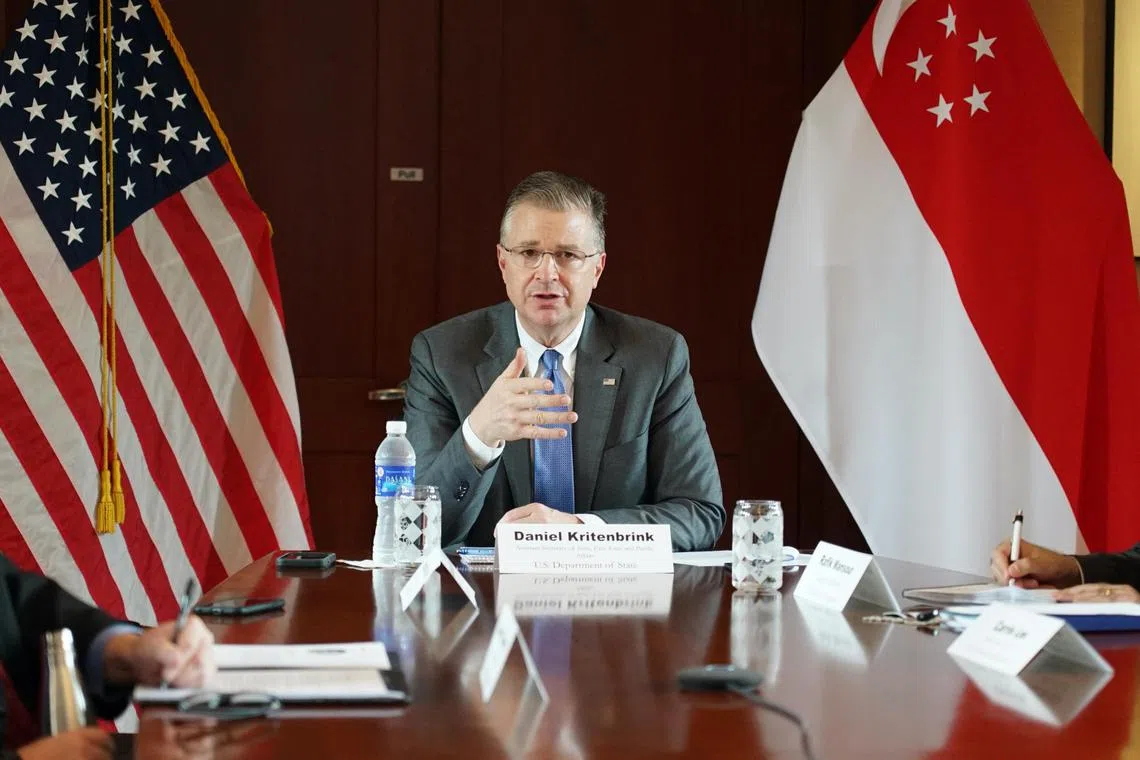US remains a ‘true believer’ in Asean, say top Biden diplomats
Sign up now: Get ST's newsletters delivered to your inbox

Analysts also noted that US President Joe Biden has looked past Asean to beef up bilateral relations.
PHOTO: REUTERS
Follow topic:
WASHINGTON - Top Biden officials are attesting to a “tremendous momentum” in ties with Asean even as the White House remains preoccupied with geopolitical crises and a closely contested presidential election less than six months away.
There is some unhappiness in regional capitals that the Israel-Palestine war and Washington’s ratcheting rivalry with China is diffusing focus on ties with Asean.
In an exclusive interview with The Straits Times, President Joe Biden’s top diplomat on East Asia, Assistant Secretary of State Daniel Kritenbrink, and US ambassador to Asean Yohannes Abraham forcefully pushed back at that perception.
“It’s simply not true that we’ve in any way reduced our engagement,” said Mr Kritenbrink.
“By every metric, we are getting into Asean at unprecedented levels. We think there’s tremendous momentum here,” he added, pointing out that the Biden administration had demonstrated its faith in Asean in a number of ways, including upgrading ties to a comprehensive strategic partnership in 2022.
Mr Biden also showed up for key Asean meetings in Phnom Penh and hosted the Asean leaders to a historic US-Asean special summit
But in the following year, Mr Biden skipped the annual Asean summit in Jakarta and sent Vice-President Kamala Harris instead.
And in 2024, when current Asean chair Laos hosts the meetings in October, the presidential election will be just a few weeks away, with Mr Biden in the final throes of campaigning.
Likewise, there is no word on whether Asean leaders will get a repeat invite to the White House in 2024.
Does that mean that Asean is no longer a priority?
Both officials dismissed the idea. They said Mr Biden had given ample proof of his commitment to Asean by placing it at the heart of his signature Indo-Pacific strategy that was launched in 2022.
“There, in black and white, is the President’s statement that Asean and this region are central to everything we do,” said Mr Kritenbrink. “We firmly believe that much of the history of the 21st century is going to be written in this region.”
The diplomats also pointed out that the US remains by far the largest investor in South-east Asia, and trade between the US and the region is worth more than US$500 billion (S$675 billion). This creates more than 600,000 jobs in the US and more than a million jobs in South-east Asia.
And Mr Biden had moved to appoint Mr Abraham as the US ambassador to Asean, filling a post that had been vacant for more than five years.
Analysts, on the other hand, note that Mr Biden has looked past Asean to beef up bilateral relations, ramping up its ties with the Philippines and Vietnam, for example.
He has also actively pursued minilateral frameworks like the Quad (US, India, Japan and Australia) and Aukus (US, Britain and Australia),

US Assistant Secretary Daniel Kritenbrink dismissed the idea that Asean is no longer a priority to the US.
PHOTO: US EMBASSY SINGAPORE
Mr Abraham disagreed. “The fact that we have an unprecedented expansion of engagement with Asean and we’ve got great bilateral relationships in South-east Asia are not mutually exclusive, they are mutually reinforcing,” he said.
“We don’t see the region, including South-east Asia, in binary terms,” said Mr Kritenbrink. “We are true believers in Asean and in its potential. Candidly speaking, Asean centrality is the reality of the region, Asean is the region’s only real formal architecture,” he said.
Nevertheless, the administration faces some criticism that it still has no robust economic strategy for the region. And that its increasingly strident rivalry with China unsettles Asean nations, all of which count China as their top trading partner. Asean’s trade with China stood at about US$975 billion in 2022.
Mr Abraham countered that the US and Asean were collaborating to solve a wide spectrum of issues, ranging from health security to the climate crisis to the digital economy.
Some of these topics were in discussion on May 24 when Mr Kritenbrink met senior Asean officials for the 36th round of the annual US-Asean Dialogue in Washington that he co-chaired with Indonesian Ministry of Foreign Affairs director-general for Asean Cooperation Sidharto Reza Suryodipuro.
A new area for exploration is artificial intelligence, Mr Abraham said. “We want to work in partnership with Asean on practical applications, on how AI plays in the digital economy and how that manifests in the digital economy framework agreement negotiations,” he said.
AI, he pointed out, has broad applications across the four components of the upgraded US-Asean partnership – connectivity, economic cooperation, maritime cooperation and sustainable development goals.
Scope for economic cooperation has also been boosted by Mr Biden’s 2022 initiative, the Indo-Pacific Economic Framework for Prosperity (IPEF),
Agreements on three of the framework’s four pillars – supply chain, clean energy and anti-corruption – have already been reached.
But the trade pillar is a point of contention. It provides no additional trade access to the US, a key demand for the trade-driven South-east Asian economies. And it faces stiff resistance from the progressive wing of Mr Biden’s own Democratic Party.
But Mr Kritenbrink said work continues on the trade pillar, adding that the progress on the IPEF had been significant and ground-breaking.
“We’re grappling with the most important cutting-edge sectors of the 21st-century economy. And negotiating our approaches to those sectors for the first time,” he said.


